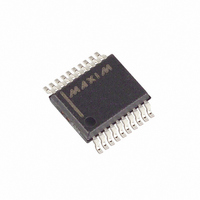MAX1142AEAP+ Maxim Integrated Products, MAX1142AEAP+ Datasheet - Page 17

MAX1142AEAP+
Manufacturer Part Number
MAX1142AEAP+
Description
IC ADC 14BIT 200KSPS 20-SSOP
Manufacturer
Maxim Integrated Products
Datasheet
1.MAX1142BEAP.pdf
(20 pages)
Specifications of MAX1142AEAP+
Number Of Bits
14
Sampling Rate (per Second)
200k
Data Interface
MICROWIRE™, QSPI™, Serial, SPI™
Number Of Converters
1
Power Dissipation (max)
640mW
Voltage Supply Source
Analog and Digital
Operating Temperature
-40°C ~ 85°C
Mounting Type
Surface Mount
Package / Case
20-SSOP
Lead Free Status / RoHS Status
Lead free / RoHS Compliant
quately bypassed, add an additional 1µF or 10µF low-
ESR capacitor in parallel with the primary bypass
capacitor.
Figures 10 and 11 show the MAX1142/MAX1143’s
transfer functions. In unipolar mode, the output data is
in binary format and in bipolar mode, it is two’s comple-
ment format.
Figure 10. MAX1143 Unipolar Transfer Function, 4.096V = Full-
Scale
Figure 11. MAX1143 Bipolar Transfer Function, 4.096V = Full-
Scale
011 . . . 111
011 . . . 110
000 . . . 010
000 . . . 001
000 . . . 000
111 . . . 111
111 . . . 110
111 . . . 101
100 . . . 001
100 . . . 000
11 . . . 111
11 . . . 110
11 . . . 101
00 . . . 011
00 . . . 010
00 . . . 001
00 . . . 000
OUTPUT CODE
OUTPUT CODE
0
+FS = +4.096V
-FS = -4.096V
1LSB = 8.192
-FS
1
14-Bit ADC, 200ksps, +5V Single-Supply
INPUT VOLTAGE (LSBs)
2
16384
3
INPUT VOLTAGE (LSBs)
FULL-SCALE
TRANSITION
Transfer Function
0V
FS - 3/2LSB
FS = +4.096V
1LSB = FS
+FS - 1LSB
FS
16384
___________________________________________________
Integral nonlinearity (INL) is the deviation of the values
on an actual transfer function from a straight line. This
straight-line can be either a best straight-line fit or a line
drawn between the end points of the transfer function,
once offset and gain errors have been nullified. INL for
the MAX1142/MAX1143 is measured using the end-
point method.
Differential nonlinearity (DNL) is the difference between
an actual step width and the ideal value of 1LSB. A
DNL error specification of less than 1LSB guarantees
no missing codes and a monotonic transfer function.
Aperture jitter (t
the time between the samples.
Aperture delay (t
edge of the sampling clock and the instant when an
actual sample is taken.
For a waveform perfectly reconstructed from digital
samples, signal-to-noise ratio (SNR) is the ratio of full-
scale analog input (RMS value) to the RMS quantization
error (residual error). The ideal, theoretical, minimum
analog-to-digital noise is caused by quantization error
only and results directly from the ADC’s resolution
(N-bits):
In reality, there are other noise sources besides quanti-
zation noise, including thermal noise, reference noise,
clock jitter, etc. Therefore, SNR is calculated by taking
the ratio of the RMS signal to the RMS noise, which
includes all spectral components minus the fundamen-
tal, the first five harmonics and the DC offset.
Signal-to-noise plus distortion (SINAD) is the ratio of the
fundamental input frequency’s RMS amplitude to the
RMS equivalent of all other ADC output signals:
SINAD (dB) = 20
SNR = (6.02
AJ
Signal-to-Noise Plus Distortion
) is the sample-to-sample variation in
AD
with Reference
) is the time between the rising
Differential Nonlinearity
log (Signal
Signal-to-Noise Ratio
Integral Nonlinearity
N + 1.76)dB
RMS
Aperture Delay
Aperture Jitter
Definitions
/Noise
RMS
)
17











